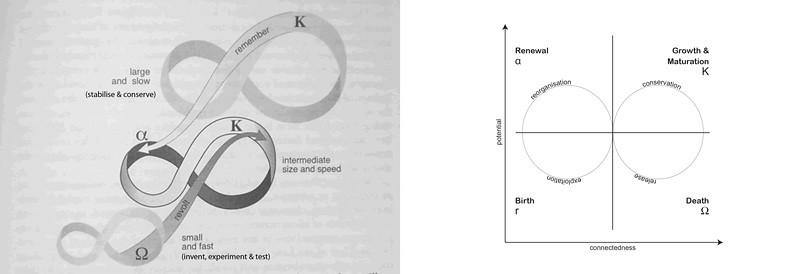Table of Contents
From Pan To Panarchy
By Anna Maria Orru and David Relan
Pan, the universal god of nature in Greek mythology, was our guardian deity on a journey to link resilience theory with future scenario building. This horned, hoofed, hairy and horny deity (Hughes 1986) represents a pervasive spiritual power in nature – with a personality to match. He is an enthusiastic, goat-legged lover of ecstasy and a dancer among stars, weaving the harmony of the cosmos into playful song. Pan also plays a destabilising role that is best captured in the word “panic.” These attributes have come to inspire panarchy, a systems theory elaborated by Lance Gunderson and C. S. Holling. We make use of this model for comparing ecological and social systems in our scenario-building toolkit — with the idea that in Pan's world, nature is comprised of both chaos and order, panic and control. Our journey in future scenario building sets out on this note.
The Panarchy Model
Panarchy is a conceptual model to help us understand the source and role of change in systems (economic, ecological, social…). As an antithesis to hierarchy, panarchy is a dynamic model where systems exist in a dynamic balance between stability and change. In panarchy growth is dependent on continuously fluctuating interactions within a system. The model's visual image is inspired by the infinity symbol, reminding us of the cyclical or spiral nature of change. As a system progresses (or “grows”) through different parts of a cycle, the degree of interaction and connection between its parts changes. The more interconnected and complex the interactions, the more static the system becomes, until “revolt” becomes inevitable to shake up stagnant and overcomplicated interactions, pruning and shifting their connections. At other times it is important to “remember” or preserve as many connections as possible. A panarchy system is thus both creative and conserving, honouring both innovation and the continuity of tradition. At times the system moves fast – these are times to invent, experiment and test; at other times it is slow in order to stabilise and conserve the accumulated memory of experiments and their results. The system sustains itself by creating, testing and maintaining adaptive capabilities. “Development” in panarchy is the process of creating, testing and maintaining opportunity.
Panarchy turns hierarchal systems into dynamic structures that have a set location, speed, time, relationship, and role. The dynamic structure of panarchy is organised into a four-phase cycle: birth/exploitation ®, growth and maturation/conservation (K), death/release (Ω) and renewal/reorganisation (α) (see figure 4b). These four cycles loop back upon themselves. becoming either more resilient or weaker.
FIGURE 4a and FIGURE 4b
- Exploitation (R): Also referred to as the “birth” phase. This stage is one of rapid expansion. Pioneer and opportunist species proliferate, building up biomass and greater connectedness. Therefore, in this stage, connectedness and stability increase. In ecological terms, this stage occurs when a population finds a fertile niche in which to grow.
- Conservation (K): Also referred to as the “growth and maturation” phase. This is a stage of slow accumulation and storage of energy and materials. Here, the biological capital is stored and connectedness reaches its peak. In ecology this stage occurs when a population reaches its carrying capacity and stabilises for a time.
- Release (Ω): Also referred to as the “death” phase. This stage occurs rapidly in a system that has become over-connected. The release of stored carbon and nutrients is triggered and causes quick and drastic changes. In ecosystems this stage occurs when a population declines due to a competitor or changed conditions.
- Reorganisation (α): Also referred to as the “renewal” phase. This stage can also occur rapidly, where the system renews itself or flips into another state. This new state may be less productive and organised than the previous state. The reorganisation phase is characterised by weak connections, weak organisation and weak regulation, and is considered to be the most unpredictable stage. In ecological terms, during this stage certain members of a population are selected for their ability to survive despite competitors or changed conditions that triggered the release.
Sources
- Lance Gunderson and C. S. Holling. 2002. Panarchy: Understanding Transformations in Systems of Humans and Nature. Washington: Island Press
- Hughes, J. D., (1986). “Pan, environmental ethics in classical polytheism.” In Religion and Environmental Crisis, E. C. Hardgrove, ed. Athens: The University of Georgia Press

